Companies are improving their mastery of social technologies, using them to enhance operations and exploit new market opportunities—key findings of our fifth annual survey on these tools and technologies, in which we asked more than 4,200 global executives how organizations deploy them and the benefits they confer.1 When adopted at scale across an emerging type of networked enterprise and integrated into the work processes of employees, social technologies can boost a company’s financial performance and market share, respondents say, confirming last year’s survey results.
But this is a very dynamic environment, where the gains from using social technologies sometimes do not persist, perhaps because it takes so much effort to achieve them at scale. Some companies, respondents indicate, reaped fewer benefits and thus became less networked, while a smaller percentage learned how to deploy these technologies to become even more networked. Executives say that their companies are using them to increase their agility and to manage organizational complexity. Many believe that if organizational barriers to the use of social technologies diminish, they could form the core of entirely new business processes that may radically improve performance.
Usage at scale and continued benefits
Social technologies as a group have reached critical scale at the organizations represented in our survey. Seventy-two percent of the respondents report that their companies are deploying at least one technology, and more than 40 percent say that social networking and blogs are now in use (Exhibit 1). These technologies are being deployed across sectors, at the high level of 86 percent of the respondents’ companies in high tech and telecommunications, but at 62 percent of companies even in the energy industry (Exhibit 2). Levels of reported benefits not only remain high when respondents’ organizations use social tools for internal purposes but have also increased among those that use them for communicating with customers or for integration with partners and suppliers (Exhibit 3).
Rising adoption rates
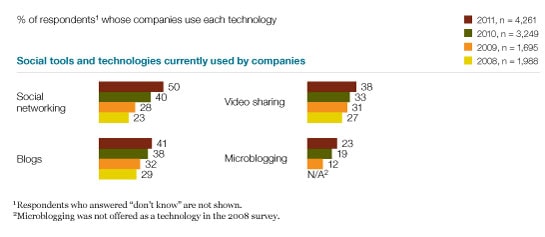
Adoption of social technologies across industries
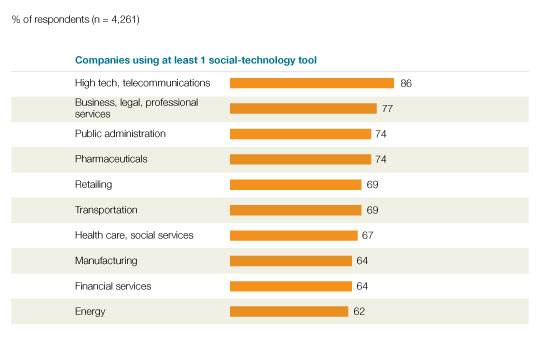
Benefits remain consistent over time
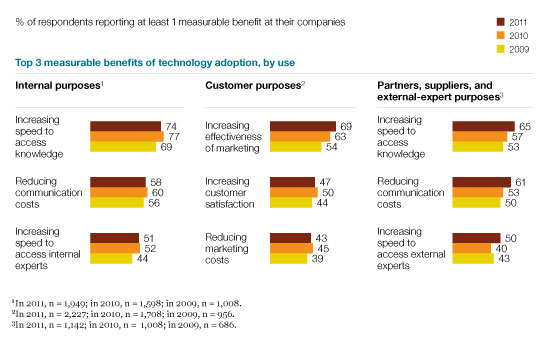
The performance edge of networked enterprises
Last year, we identified a small group of respondents who indicated that their companies had experienced superior performance from the use of social technologies across key stakeholder groups. We repeated the analysis this year, looking at the average level of improvements in business benefits that executives reported. Four clusters emerge from our analysis. Executives at internally networked organizations note the highest improvement in benefits from interactions with employees; those at externally networked organizations, from interactions with customers, partners, and suppliers. Executives at fully networked organizations report greater benefits from both internal and external interactions. In the fourth and by far the largest group, developing organizations, respondents report lower-than-average improvements across all interactions at their organizations.2
As we found last year, the number of fully networked organizations is small. But the percentage of externally networked organizations is higher and that of internally networked ones lower (Exhibit 4),3 reflecting the fact that the gains from the use of social technologies are not static (see discussion below). We call the companies in the fully and externally networked groups extended enterprises, since their use of social technologies in customer and partner outreach blurs the boundaries of the organization.
Tracking the four types of organizations
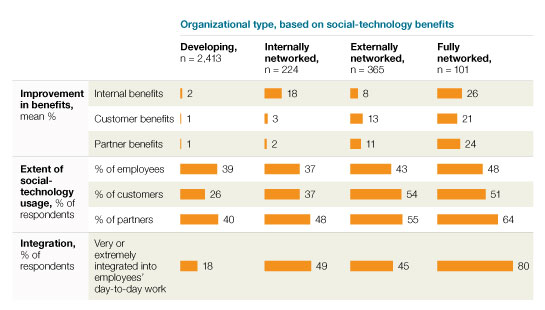
We found statistically significant correlations between self-reported corporate-performance metrics and certain business processes that networked enterprises use (Exhibit 5). The market share gains respondents report are correlated with two such processes. First, these organizations use social tools to scan external environments. Second, they use them to match employees to tasks: internal wikis and social networks help project leaders to identify employees with the most appropriate skills and to assign these employees to the projects for which they are best suited.
Correlations with corporate performance
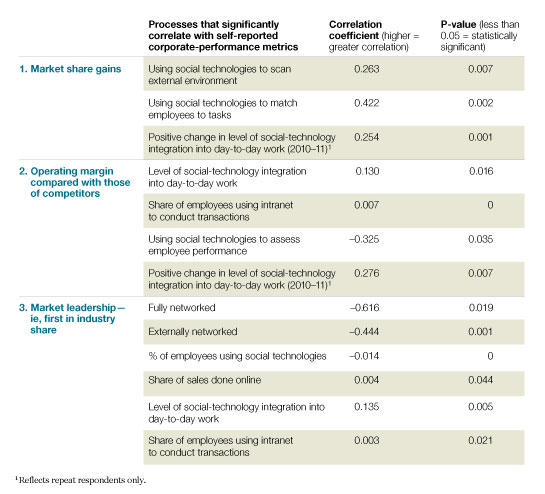
Another key performance measure, self-reported operating-margin improvements, correlated positively with the reported percentage of employees whose use of social technologies was integrated into their day-to-day work. Among the companies of respondents who took the survey in previous years, these improvements also correlated positively with gains in the reported percentage of employees whose work is highly integrated with social media. Market share leadership in an industry, the final self-reported performance measure, correlated positively with the integration of social tools in employees’ day-to-day work, as well. Consistent with last year’s analysis, we found that market leadership correlates negatively with fully networked and externally networked organizations. While market leaders may use social technologies within the organization, they might be less inclined than market challengers to push for a full range of benefits.
Networked organizations: Not a steady state
We also analyzed the responses of executives who participated in both the 2010 and 2011 surveys for changes in our defined enterprise clusters. According to these responses, a surprising number of organizations made the transition from one type of enterprise to another. Roughly half of the internally and externally networked enterprises slid back into the category of developing organizations; that is, they did not maintain the benefits of using social technologies that they had achieved earlier. Less than 15 percent of the companies in any given category moved up to the next tier—in other words, from a developing to a networked enterprise or from an internally or externally networked enterprise to a fully networked one (Exhibit 6). It appears that it is easier to lose the benefits of social technologies than to become a more networked enterprise, which suggests that significant effort is required to achieve gains at scale. We also found initial indications that if the percentage of employees who integrated social technologies into their day-to-day work declined, their companies were more likely to backslide.
Shifting network classifications
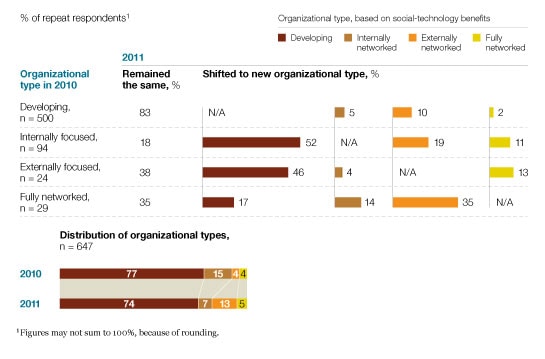
Changing processes
We asked respondents about current and future uses of social technologies for a range of business processes and found that the greatest number say their companies use these tools to scan the external environment for new ideas. Respondents also report that different technologies are better suited to specific types of business processes, as the accompanying heat map shows (Exhibit 7). Social networking and blogs, in particular, are used most heavily in externally focused processes that gather competitive intelligence and support marketing efforts.
Respondents expect social technologies to modify many of their organizations’ current processes. In addition, many believe that entirely new processes could arise if barriers to use—cultural obstacles, for example—fall (Exhibit 8). The respondents affiliated with fully networked organizations are the likeliest to believe that greater process change will occur in their own organizations. In larger numbers than respondents in other clusters, they think that social technologies will lead their companies to adopt entirely new processes under current conditions and to do so even more aggressively if all constraints were removed. This optimistic view may reflect the fact that these respondents are seeing the greatest level of benefits across the board.
Peering ahead three to five years, many respondents expect still more profound organizational changes (Exhibit 9). They say that with fewer constraints on social technologies at their companies, boundaries among employees, vendors, and customers will blur; that more employee teams will be able to organize themselves; and that data-driven decision making will rise in importance.
Supporting a variety of processes
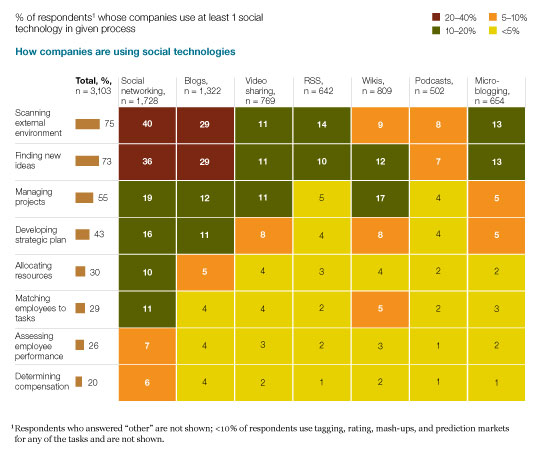
A mix of old and new
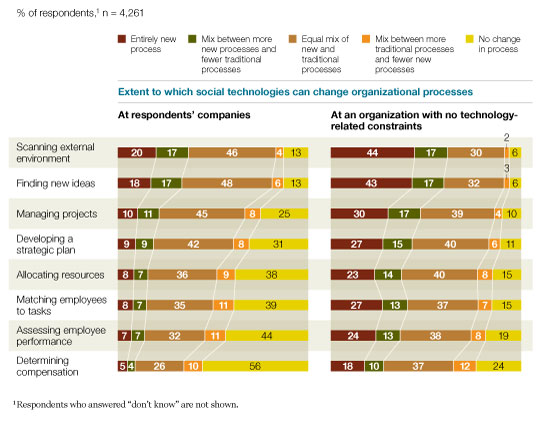
A blurring of boundaries
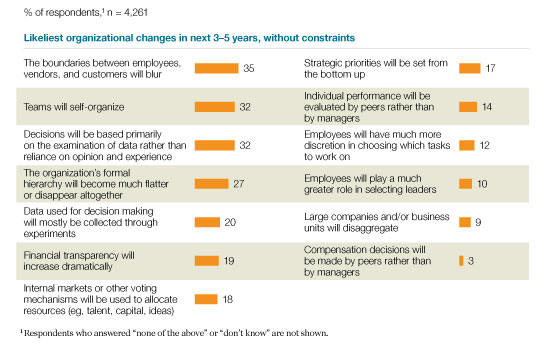
Looking ahead
Our research shows that respondents affiliated with fully networked organizations say that they continue to realize competitive gains and performance improvements. Senior executives should think strategically about how social technologies can support business processes by helping organizations to navigate the external environment and to forge stronger links with customers and vendors. Integrating social technologies into the workflow and using them to optimize internal processes will, these results suggest, provide additional competitive benefits.
Don’t rest on your laurels: competition will increase as the adoption of social tools and technologies continues to rise and as progressive companies use them to improve their processes. Indeed, many companies we categorized as networked organizations last year slipped to a lower rung this year as the benefits their executives reported fell. Integrating Web technologies into the daily workflow, our results suggest, is the most effective way to maintain competitive position or become more networked.
Companies should prepare for more substantial disruptions. Since many executives believe that significant changes will occur as (or if) constraints on social tools and technologies are lifted, companies that can create change themselves—instead of reacting to it—are likely to benefit the most.


